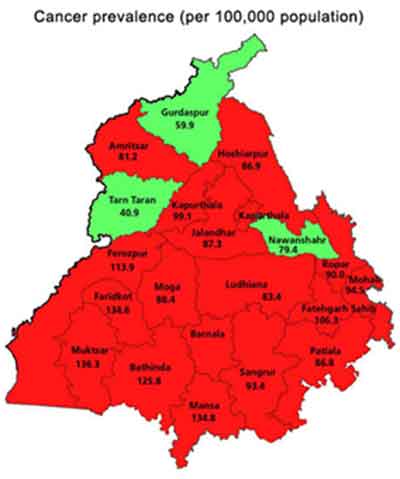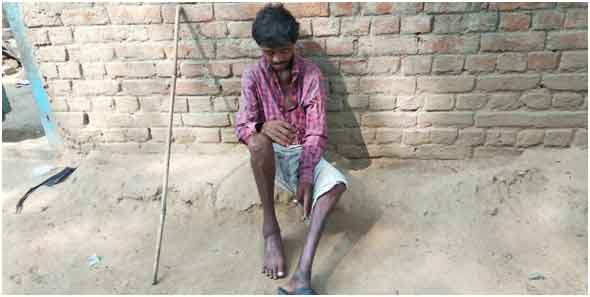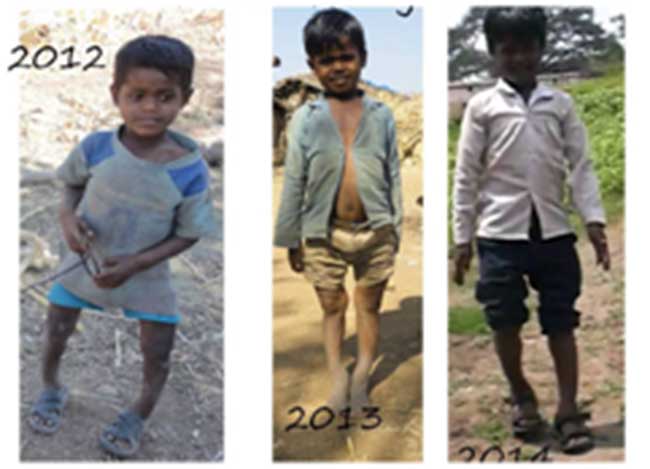
Of the total 75 districts in Uttar Pradesh (UP), 63 districts have fluoride above the permissible limit and 25 districts are affected by high arsenic, as per May, 2019 data of the UP’s Department of Drinking Water and Sanitation, marked in the map above. (Courtesy: Gaon Connection.com)
UP is the largest Indian State, with a population of over 200 million, i.e., equal to around three big countries of Europe. UP supplied most of India’s prime ministers ever since 1947, the latest being Narendra Modi, the Gujarati leader who chose to be elected to Loksabha from the ‘sacred town Varanasi, along sacred river Ganga’ in UP.
‘Sacred’ but the waters are not pure, not safe, not potable
This is part-1 of an article on UP’s Drinking Water problems, focused on contamination by high fluoride and arsenic.
While excess Fluoride is a slow poison, Arsenic is a deadly poison spreading in most of the Gangetic-Brahmaputra belt. More than one lakh villages are in this danger zone that includes UP.
Legislative Assembly elections are scheduled to be held in UP from 10 February to 7 March 2022 in seven phases to elect all 403 members : the results will be declared on 10 March 2022.
The polity, hence the big media, is lost amidst rapacious political forces working 24x7x365 to grab and retain power with no concern for the well-being of the people, more so the toiling masses. Amidst so many ‘welfare schemes’, and huge budgets, meant more to swindle funds than to deliver goods, the most serious problem of drinking water, of fluorosis, and of arsenicosis, continues to be neglected, despite the Indian State admitting its seriousness.
UP Assembly had polls in 2017 with a turnout of 61percent and BJP got 39.67 of polled vote, and formed the govt., part of a ‘double-engine’ promised by PM Modi. He said UP was let down by all parties, and assured the State would turn a new leaf. BJP had ruled UP earlier too.
The ‘double-engine’ Modi-Adityanath had promised many things, Sab ka Vikas: but the ‘development’ for all could not ensure potable drinking water to all.
“ I was hoping things would change, but nothing has,” said a villager as he loaded his last piece of luggage onto the tractor that would carry them away from his ancestral home. It is not any remote areas of UP that faced the problem. Dakari village in Unnao district, 70 kilometres from the state capital, Lucknow, is one of hundreds of such villages that are denied safe water for years. It is affected due to a cocktail of contaminants in their groundwater, the only source of drinking water for millions.
*** ***
“1,427 villages,” one third of all in Unnao district, have water with high amounts of fluoride
UP is not alone. Modi’s Swatch Bharat Mission (SBM) for India had no stress on Swatch (pure) water.
Swach Bharat Mission (SBM) is impossible without Swach Jal. Sab ka Vikas is not possible without safe drinking water to all. Make in India is impossible when crores of people, more so the toiling classes, are down with diseases and are crippled.
But all these slogans are peddled in the poll campaign.
Now 335 Indian districts are admittedly affected ( almost half of India’s total districts ) with fluorosis. (District in India, unlike the connotation in the West, refers to a large administrative division, each with population often running into lakhs, some even more than a million.) Plus the Ganga-Brahmaputra belt, with another menace : Arsenic in water! A deadly poison !
See the following estimates indicating aggravation of the problem over the years despite claims of development:
–1974: 25-30 million (2.5 to 3.0 crore) people at risk and half a million (5lakh) were reported crippled.
–1999 (UNICEF): 201 districts affected and 60 million at risk. 6 million people crippled.
–2009(Ministry of health and family welfare): 275 districts are affected and 66 million people are at risk in endemic areas. 6 millions are crippled.
–2017 (Ministry of Water Resources) : Fluorosis in 335 dts, around 10 crore people threatened. Arsenic 153 dts.; 7 crore people by Arsenic in water.
Thus it is an all India problem. The ‘double engine’ of UP has not solved it.
According to reports, there are approximately 257,672 people living in the 4,355 villages in 1,445 gram panchayats of Unnao district. Of them, 1,427 villages were found to contain high amounts of fluoride — between 2.20 mg/l and 4.20 mg/l — in their groundwater according to the testing lab of the state.
The Bureau of Indian Standards’ (BIS) Drinking Water Standards IS 10500:2012 specifies an ‘acceptable’ limit of fluoride in drinking water as 1 milligram per litre (mg/l), but in the absence of a safe water source, the ‘permissible’ limit of fluoride is 1.5 mg/l.
However, in an International conference on Fluorosis held at NIN, Hyderabad, in November 2016, experts from International Society for Fluoride Research (ISFR) proposed that safety levels of fluoride in drinking water in India should be fixed at 0.5 ppm (parts per million) from the existing 1 ppm. This consensus was reached by experts at the 33rd International Conference of ISFR, attended by FMRRC too. FMRRC had found in its field studies, people developed symptoms in villages that reported even 0.7mg/l.
Not far from UP’s capital Lucknow, in Unnao dt, that is the situation. After Ayodhya, BJP has been harping on Varanasi and Mathura. They are speaking of building temples there. But people there are worried about the very basic issue of drinking water.
Varanasi dt has been notorious for contamination of water as we shall see later. Baldeo block in Mathura district, for instance, reported fluoride levels up to 5.9 mg/l, as recorded in the Ground Water Year Book 2019-20 of the Central Ground Water Board, under the Union Ministry of Water Resources. Ghazipur (4 to 5mg/l) and Azamgarh (3.5mg/l) are among the districts with worst sources of water. The list below shows some places with unsafe water, with F above 1.5mg/l, three times the safe limit as per experts.

Pieshe, Mathura, UP: “I never had enough water in my entire life.”
Pieshe, who lives in Maura village in Mathura Dt of UP faced a lot of trouble due to water shortage in the pandemic…she has been suffering for water for long. “Hamne paani ka sukh to kabhi dekhyo na hai (I never had enough water in my entire life),” she lamented. “It has been 35 years of our marriage but I have been struggling for water for long. Every day I have to walk to another village to fetch water. Aadmi jiye ya mare, hume wanhi se paani lana hota ha (Whether we live or die, we have to bring water from there only),” she said, exasperatedly.

The data is bad enough, gives the picture at macro level, but the pathetic life can be seen better by some concrete stories: Sumit Yadav filed a pathetic report (June 19th, 2021) for gaonconnection.com, an online magazine that focuses on rural issues. Pankaja Srinivasan also contributed:
Shiv Kumar, along with his family of seven, is leaving behind his ancestral home in Dakari, village with a population of 609, in Unnao district. “I am the third generation that has lived in this house,” said the 54-year-old, resignation and sadness in his voice as he prepared to depart the home where his grandfather and father lived and breathed their last, and where he himself grew up.
Water is the reason why Shiv Kumar is moving home and hearth to another village. The highly contaminated quality of water, he said, was driving them away. “It is poison that comes out of the handpumps, not water,” he said.
UP Jal Nigam, Unnao’s water quality test report for Sikandarpur Karam block, where Shiv Kumar’s village is located, showed total dissolved solids (TDS) level of 4,089 milligram per litre (mg/l) against the desirable limit of 500 mg/l. Total hardness of water was found to be 2,072 mg/l as against the desirable limit of 300 mg/l.
“Not potable for TDS, chloride, hardness, alkalinity,” reads the water quality report dated May 28, 2021. Gaon Connection said it has a copy of the test result.
The situation is complicated by more man-made problems: “There is discharge of chemical laden water from the leather tanneries nearby. And, every day the water in our village is getting more and more polluted,” Raghavendra Singh from Dakari, told Gaon Connection. Something in the water is so corrosive that it is eating into the metal of the handpumps and taps, he added.
*** ***
Chronic problem and Dubious claims
The district authorities aren’t unaware of the plight of Dakari residents. About two decades back, the government laid a pipeline all the way from Poni village about five kilometres away from Dakari. It is meant to supply clean water to the village.
“But because of old, rusted pipes, the water barely makes it to only one or two taps in the common public areas in Dakari. The supply is just once a day at six in the morning, for just one hour and we manage to get only about eight to ten litres from it,” Raghavendra complained. The rest of the water needs of villagers are met through the contaminated groundwater.
“One reason for the high incidence of fluoride in the groundwater is because of the geographical lay of the land; it is naturally occurring there in the aquifers,” Mohit Chak, Executive Engineer (EE) of Unnao’s water board, told Gaon Connection.
There are other reasons too. As many as 71 drinking water schemes were introduced in the district about 25 years ago, informed the Executive Engineer. “These were schemes that were designed to last for not more than 15 years. So, most of the schemes are defunct now, or not running on full capacity,” he pointed out.
When Gaon Connection enquired about the poor quality water coming from the handpumps, Mohit Chak said that the uppermost layers from where the hand-pumps drew their water, were the most vulnerable to contamination as effluents easily leached into them. Water taken from below the depth of 300 metres was found to be safe for drinking, he reportedly said.
The central government’s Jal Jeevan Mission Yojana will reactivate the older drinking water schemes, Chak said. This scheme of the Ministry of Jal Shakti promises piped water for every household in India by 2024.
“The work to provide potable water to every household in Unnao district will start soon,” assured Chak. And, the new tubewells that will be installed under the scheme will draw water from below 300 metres, he said.
But the claims made are dubious for many reasons. Elsewhere, it was widely found, the contamination with such dissolved solids like Fluoride was higher at deeper layers. We do not know if his claims are backed by any field studies.
Villagers complain they have no knowledge of the water quality of the handpumps that are their only sources for drinking water. “Many times people who test the quality of the water have taken samples of the village water. But no one came back to tell us what they found in it,” Sishupal Yadav from Raghunath Kheda told Gaon Connection.
Chak responded: “The results of the testing are uploaded onto the ejalshakti portal and anyone can have access to it and find out the results,” he informed. Few are aware.
But, till that happens, villagers like Sishupal Yadav continue to worry. “People hesitate to give their daughters in marriage to our boys. They do not want to send their girls to a village where the water is rotting and cripples people for life,” he said.
Poison in groundwater
25 districts out of UP’s 75 report water sources with high Arsenic , 63 report high Fluoride, and 18 have both menaces, as can be seen in the Table below, based on official data. Only three districts (Allahabad, Bareilly and Basti) are shown to be free from any of these two problems. There would be other contaminants like nitrates and bacteriological.

Consuming water with high fluoride or arsenic leads to a number of health problems including fluorosis, a crippling disease; and arsenicosis (also linked to cancer), respectively.
Exodus from Dakari
“We are helpless and therefore have to drink this very same water knowing fully well it cannot be good for our health,” Shanti Devi, who sat scrubbing vessels at a handpump, told Gaon Connection. “When we are really thirsty, we drink a glass or two of the foul smelling water and then wash it down with the good water we buy,” she added.

Shanti Devi said that if the water quality did not improve, her family too will have no other alternative than to leave the village. “The water is yellowish and as a result the clothes we wash in it get discoloured; vessels turn black and the floors at home also get a dirtyish hue,” she complained. (see photo above.)
Those who can afford to, are leaving these villages. But what happens to a large chunk of the village population that cannot leave behind its homes and has nowhere to go?
Sixty-five-year-old Indrana came to Raghunath Kheda village of Unnao some 40 years ago after her wedding. The young bride did not know what was in store for her.
“Back then, the water was fine and so was my health. It is in the last ten years that the quality of water has become terrible and along with it I began experiencing trouble with my back,” Indrana told Gaon Connection. And as she stood up from beside a water trough meant for cattle, it became apparent that she was bent over double.
According to Indrana it was not just her, many other men and women in Raghunath Kheda village (1,200 population), about 10 kilometres away from Dakari village, suffered from misshapen bones. All she knew, she said, was that till 10 years ago, the water was fine and so were her bones. But not anymore.
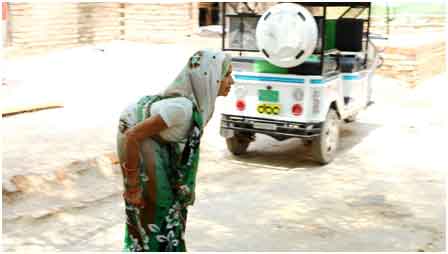
Drinking high fluoride water leads to fluorisis which in bad cases affects the bones: It is not a problem caused by old age.
Like Indrana, 38-year-old Manju Devi also said that when she came to Raghunath Kheda after her wedding 20 years ago, there were no problems with the water. “Now, I feel like throwing up even if I rinse my mouth with the water,” she told Gaon Connection. I cannot remember when I last drank sweet water to my heart’s content, she said sadly.
“I am constantly unwell. I struggle to sweep the floor on account of painful knees, a bad back,” Manju Devi said, blaming the contaminated groundwater of her village.
Her family buys water from an RO (reverse osmosis) plant for cooking and drinking; the floors of her house remain dirty no matter how much they are scrubbed, and their handpump is completely eroded.
Meanwhile, Sishupal Yadav from Raghunath Kheda complained that people had stopped visiting their village, and if anyone did visit, they brought water along with them.
Yadav told Gaon Connection that villagers go to other villages to fetch 15 to 20 litres of water to be used by the entire family. “We pay twenty rupees for the water, and spend about the same for the petrol to go there and bring water home,” he said.
*** ***
No supply of safe water, UP fares very badly, even in anganwadis
The data of the Union Jal Shakti Ministry shows the worst performing states and union territories in terms of tap water connection to anganwadis are Assam (1.84 per cent), Jharkhand (2.51 per cent), Uttar Pradesh (5.08 per cent), Chhattisgarh (5.40 per cent) and West Bengal (5.79 per cent).
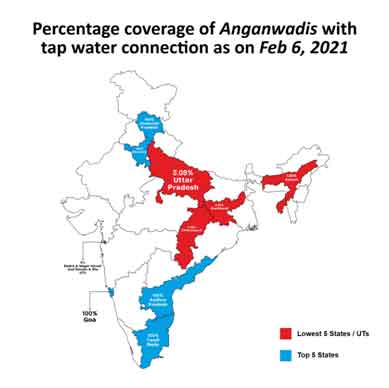
Source: Jal Shakti Ministry, Government of India
To provide tap water supply to rural households, including anganwadis and rural schools, the Modi government launched its flagship scheme of Jal Jeevan Mission in 2019. The aim is to cover all rural households by 2024.
However, latest data by the Union Jal Shakti Ministry shows that as on February 6, 2021, only 39.8 per cent anganwadis are covered with tap water connections. Of the total 1,158,405 anganwadi centres in the country, functional tap water connections are provided to 461,191 anganwadi centres only. In India, 158 million kids are registered with the 1.36 million functional anganwadi centres spread across all the districts in the country (as of June 2018). (gaonconnection.com)
Lack of tap water connection to anganwadis means additional burden on the anganwadi workers and helpers who have to walk long distances to fetch water. Often young kids, under the age of six who come to anganwadi, end up consuming unsafe drinking water.
“The tap and pipeline may reach, but what about the water in it?” CSE asks.
The Union Budget 2021-22 document shows the combined budget allocated for the Saksham scheme, which includes four programmes: ICDS, Poshan, creches, and scheme for adolescent girls, is Rs 20,105 crores. This is even less than Rs 20,532 crores given to ICDS alone in 2020-21.
However, there are some states that have achieved 100 per cent coverage of tap water connections to their anganwadi centres. These include Andhra Pradesh, Goa, Haryana, Himachal, Tamil Nadu, and Telangana, which have 100 per cent coverage.
Data shows that drinking water sources in more than 53,000 habitations spread across 21 states in India are contaminated with various toxic pollutants, including high levels of cancer-causing arsenic, and fluoride, which deforms bones and cripples people for life. Due to high fluoride content in water, children are unable to walk and have stained teeth.
According to the report of the World Health Organization, 2019, contaminated water and poor sanitation are linked to transmission of diseases such as cholera, diarrhoea, dysentery, hepatitis A, typhoid, and polio. Of India’s more than 2.3 million annual deaths among children, about 0.3 million (334,000) are attributable to diarrhoeal diseases, reports WHO.
Alok Pandey, physician at the Unnao district hospital, said children were more vulnerable to the adverse effects of fluoride in the water sources and it reduced their immunity; other studies showed it impairs their IQ , among many other problems, dental fluorosis being only the most visible part of the damage.
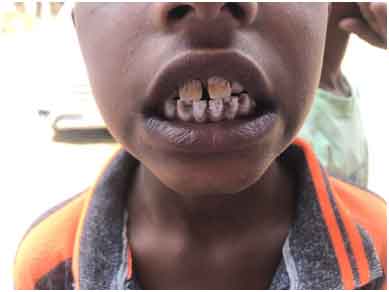
Fluorosis caused due to ingestion of high fluoride leads to staining of teeth in children, not merely a cosmetic problem. It also cripples kids if no remedial measures are taken. (Pic: Nidhi Jamwal)
Suresh Kumar Rohilla, senior director with Centre for Science and Environment, New Delhi, raises similar concerns. “The Jal Jeevan Mission Urban takes up some issues related to water and sanitation.. it is a good thing,” he told Gaon Connection. “But the question remains where will water for 28.6 million urban households come from? A large number of cities and towns already face water scarcity. Most urban water bodies are polluted and encroached. Sourcing safe water locally will need proper planning,” he said. “At present, it seems we have put the cart before the horse. The tap and pipeline may reach, but what about the water in it?” he asked.
It was in 2019 that the Narendra Modi government launched its flagship scheme of Jal Jeevan Mission (Rural) to provide tap water supply to rural households. The aim is to cover all rural households by 2024.
The Report of the Comptroller and Auditor General of India (CAG), tabled in Parliament in August 2018, found that the government had failed in achieving the targets of the 12th Five year plan (2012-2017) under its central flagship National Rural Drinking Water Programme.
Under the programme, the government had announced to make safe water accessible to all rural habitations, government schools and anganwadis, and potable water to 50 per cent of rural population. Besdies this, 35 per cent of rural households were to be provided household connections by 2017.
However, as of December 2017, only 18 per cent of the rural population could be provided piped potable drinking water (55 litres per capita per day) while a mere 17 per cent of rural households had household connections, noted the CAG report.
Himanshu Thakkar, coordinator of South Asia Network on Dams, Rivers & People, raised a similar concern on the sustainability of water sources. “Neither Jal Jeevan Mission, nor the next phase of Swachh Bharat Mission includes sustainability or proper assessment of social and environmental impact, and using this understanding in decision making. So, investment under the mission is likely to be environmentally hazardous,” he told Gaon Connection.
*** ***
Skeletal Fluorosis Around Varanasi

Danger of skeletal fluorosis : See legs affected, From around Varanasi.
(Source : Varanasi Hindi News – Hindustan
Skeletal fluorosis occurs only when the high fluoride problem is left untackled for long years. It is also associated with poverty and malnutrition apart from bad drinking water.
Tall claims of Vikas Vs Poor Record, as per CAG
More than 163 million Indians–more than the population of Russia–do not have access to safe drinking water, and the national rural drinking water programme, despite spending 90% of Rs 89,956 crore over five years to 2017, has “failed” in its targets, according to an August 2018 report from the government’s auditor, CAG.
See this extract from an analysis of the CAG report by Shreehari Paliath, dated November 26, 2018, in indiaspend.com:
“ The programme’s target: Providing 35% of rural households with water connections and 40 lt–about two buckets–of water per person per day. Less than half that target was achieved, thanks to “poor execution” and “weak contract management”, said the audit report from the Comptroller and Auditor General (CAG).
“About 78% of 1.7 million rural Indian habitations have access to the minimum required quantity of water, 40 lt–roughly two buckets of water–per person per day, but that does not mean they actually get this water, experts said.
“As of December 2017, only 44% of rural habitations.. only 18% of rural population were provided potable drinking water by piped water supply and only 17% of rural households were provided household connections,” said the CAG report.
“ The proportion of rural habitations with safe drinking water increased by no more than 8% at 40 lpcd and 5.5% at 55 lpcd after spending Rs 81,168 crore during the period 2012-17; 90% of Rs 89,956 crore (central share of Rs 43,691 crore and state share of Rs 46,265 crore) provided for the programme was spent over this period, the CAG report said. The highest expenditure (84%) was in 2014-15.”
https://www.indiaspend.com/national-rural-drinking-water-programme-failed-to-achieve-targets-government-auditor-heres-why/
The highest expenditure (84%) in 2014-15 is presumably related to an election year. It is presumably a hang-over of the previous UPA Govt. that lasted upto summer 2014. Evidently, election times see such surge in spending, and that helps election funds of ruling parties, by huge pilferages. And note that later years saw only 16 percent spending, ie., under NDA, which led by kaamdar PM, obviously spent very little after the elections were over, and failed to meet the targets. Huge corruption and mismanagement can be visualized by the fairly huge expenditure within a short range of time.
Despite such claims of expenditure, we saw above, the results are poor.
To highlight neglect of the fluorosis problem, token election contests were organized in Varanasi, UP, amid severe hurdles by the Govt agencies. They were meant to tell the kaamdar PM of the failure of governments led by him and by his colleagues including Adithyanath.
thehindubusinessline.com, on April 09, 2019, had reported :
Twenty victims and activists from the fluorosis-hit States are going to file nominations on April 22. After years of protests, they along with 18 others have decided to file nominations from Varanasi and Rae Bareli, from where Prime Minister Narendra Modi and Congress President Rahul Gandhi are going to contest, respectively.
Elections come and go, but people are not assured of safe drinking water, more so in UP with a double-engine Government.
Part-2 of the article will focus on problems other than high Fluoride, like Arsenic and mercury.
*** ***
(FMRRC, Fluorosis Mitigation Research and Resource Centre, based in Hubli, Karnataka, is a small group with Dr. KS Sharma (1934-born Law Professor cum veteran Trade Union leader, ) as its Founder- Chairman, and Dr. M. Bapuji, Senior Scientist Ex-CSIR as its Scientific Advisor. It is not an NGO, but is part of a larger mass movement of workers (IRTUC) and rural poor ( Krantikari Janandolana) of Karnataka. FMRRC believes drinking water is a fundamental right derived from right to life…there is a need to relentlessly SEAM (Sensitize, Educate, Agitate and Mobilize) on this issue.
For enquiries email to [email protected].
For more information on Fluorosis,see our earlier articles in CC including the one below:
Socio-Political and Economic Aspects Of Fluorosis (2016)
https://countercurrents.org/2017/04/socio-political-and-economic-aspects-of-fluorosis/

